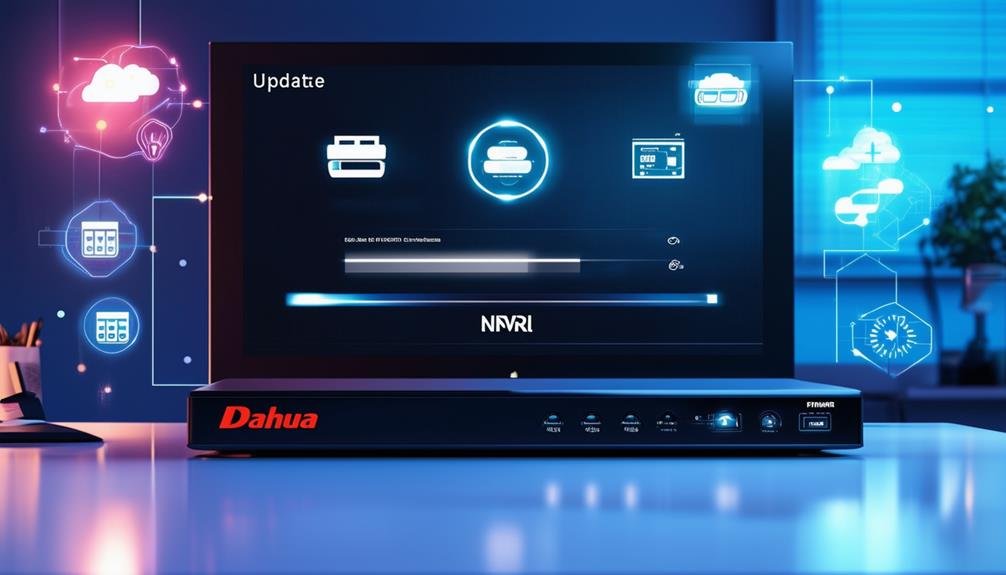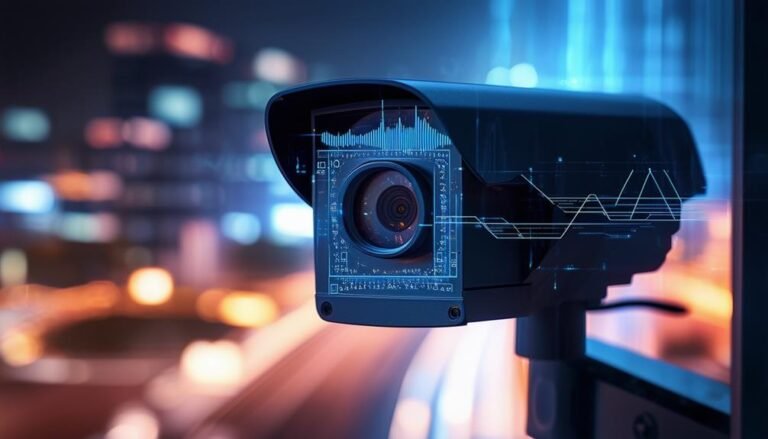To update your Dahua NVR firmware, start by logging into the device with admin credentials. Check your current firmware version under the "Settings" menu. Back up your settings and guarantee you have a stable power supply and internet connection. Download the latest firmware from the official Dahua website, selecting the specific model. Connect to the NVR's interface, initiate the upgrade option, and upload the firmware file. Wait for the process to complete and verify the update by checking the firmware version again. There's more useful information available to help you navigate through any potential issues.
Understanding Firmware Basics
Firmware acts as the essential software that controls your Dahua NVR, enabling it to perform important functions. It's the backbone of your device, ensuring that all components work harmoniously together. Think of firmware as the operating system for your NVR; it manages everything from video processing to network connectivity. Without it, your NVR wouldn't be able to function effectively.
Understanding firmware basics is important for anyone wanting to maximize their security system. Your NVR's firmware is designed to be updated regularly, allowing you to benefit from enhancements, bug fixes, and new features. These updates can improve performance, support new technologies, and even patch vulnerabilities that could compromise your system. By keeping your firmware up to date, you're taking an active role in maintaining your security and ensuring your system operates at its best.
You might wonder how these updates affect your freedom. An updated firmware can expand your NVR's capabilities, giving you more control over your surveillance system. With the right firmware, you can customize settings, integrate with smart home devices, and even access your footage remotely. This flexibility allows you to tailor your security experience to your specific needs, empowering you to take charge of your safety.
In essence, understanding firmware basics equips you with the knowledge to make informed decisions about your NVR. Stay vigilant, keep your firmware updated, and enjoy the freedom that comes with a well-functioning security system.
Checking Current Firmware Version
You should regularly check your current firmware version to guarantee your Dahua NVR is up to date. Keeping your firmware current not only helps with performance but also enhances security. Here's how to quickly find your current version:
- Log in to your Dahua NVR using your admin credentials.
- Navigate to the "Settings" menu.
- Look for the "System" or "About" section, where you'll find the firmware version displayed.
To make things clearer, here's a quick reference table:
| Step Number | Action | Notes |
|---|---|---|
| 1 | Log in to NVR | Use admin credentials |
| 2 | Go to "Settings" | Main menu option |
| 3 | Locate "System" or "About" | Firmware version shown |
| 4 | Record the version | Note it for future reference |
Preparing for the Update
Before diving into the update process, it's important to prepare your Dahua NVR properly. This step guarantees the update goes smoothly and minimizes any risk of disruption. First, make sure you have a stable power supply. An unexpected power loss during the update can lead to serious issues, possibly bricking your device. If possible, plug it into an uninterruptible power supply (UPS) for added security.
Next, it's critical to back up your current settings and data. This way, if anything goes wrong, you won't lose configurations or footage. Use the NVR's built-in backup feature to save your settings to a USB drive. Store this drive somewhere safe, so you can easily access it if needed.
Check your network connection as well. A reliable internet connection is necessary for the update to download and install correctly. If you're using Wi-Fi, consider switching to a wired connection for more stability during the process.
Lastly, familiarize yourself with the NVR's interface and update process. Knowing where to find the update options can save you time and frustration later on. Make sure you have the necessary login credentials handy, as you'll need them to access the update section.
Downloading the Latest Firmware
Once you've prepared your Dahua NVR for the update, the next step is to download the latest firmware. Getting the right firmware is crucial to guarantee that your NVR runs smoothly and efficiently. Here's how to do it:
- Visit the Dahua website – Go to the official Dahua Technology site and navigate to the support section.
- Find your model – Look for your specific NVR model in the download area. This guarantees you're getting the correct firmware.
- Check for the latest version – Confirm that you're downloading the latest version available, as firmware updates often fix bugs and improve performance.
- Read the release notes – Take a moment to glance over the release notes. They provide essential information about the features and fixes included in the update.
- Download the firmware file – Click the download link to save the firmware file to your computer. Make sure to note where you save it, as you'll need to access it later.
After downloading, you're one step closer to enhancing your NVR's functionality. By keeping your firmware up to date, you're not only optimizing your security system but also embracing the freedom that comes with having the latest technology at your fingertips. Enjoy the peace of mind that comes from knowing your NVR is equipped with the best tools available, ready to serve you in keeping your home or business secure.
Accessing the NVR Interface
To access your Dahua NVR interface, you'll first need to connect to the NVR network. Once you're connected, you can log into the interface using your credentials. This step is essential for managing settings and updating firmware efficiently.
Connecting to NVR Network
How can you ascertain a smooth connection to your NVR network? First, you need to make certain your NVR is properly connected to your router or switch. Use an Ethernet cable for a stable connection. Next, ascertain your computer or mobile device is on the same network. This will allow you to access the NVR interface effortlessly.
Here are a few steps to take into account for a seamless connection:
- Check Ethernet cables: Make sure they're firmly connected and undamaged.
- Verify IP settings: Ensure your device has a matching IP address with the NVR.
- Disable firewalls: Sometimes, firewalls can block communication between devices.
- Use the right software: Install any necessary applications or plugins for smooth access.
- Restart devices: A simple reboot can often resolve connection issues.
Logging Into NVR Interface
With your NVR connected to the network, accessing the NVR interface is the next step. To get started, open a web browser on your computer or device. In the address bar, type in the IP address of your NVR. If you're unsure of the IP address, check your network settings or refer to the NVR's manual. Once you hit enter, you should see the login page.
Now, enter your credentials. If you haven't changed them, the default username is usually "admin," and the default password is typically "admin" or left blank. It's essential to change these defaults for security reasons once you're in. After entering your details, click the login button.
You'll then be directed to the NVR interface, where you can manage settings, view live feeds, and update firmware. Take a moment to explore the dashboard; it's designed to give you easy access to all features. Keep in mind that maneuvering this interface can feel liberating, as it allows you to customize settings to suit your specific needs. Enjoy the freedom to monitor your security setup with ease!
Uploading the New Firmware
Uploading the new firmware to your Dahua NVR is an essential step in guaranteeing ideal performance and security. Once you've logged into the NVR interface, it's time to take action. You'll want to follow these straightforward steps to upload the new firmware properly:
- Select the "Upgrade" option in the settings menu.
- Browse your local storage to find the downloaded firmware file.
- Confirm the file selection to verify you're choosing the right version.
- Initiate the upload process, keeping an eye on the progress bar for updates.
- Wait for the system to reboot automatically after the upload is complete.
As you go through this process, remember that it's vital to maintain a stable power supply and internet connection. You wouldn't want any interruptions while uploading your firmware. By following these steps, you're not just updating software; you're enhancing your NVR's capabilities, making it more resilient against potential threats.
Embrace the freedom of knowing your surveillance system is up-to-date and functioning at its best. Once the upload is underway, you can feel a sense of relief, knowing you're taking the necessary steps to protect your assets. So, gear up and let the firmware do its magic. You'll be glad you took the time to guarantee everything's running smoothly!
Verifying Successful Update
After you've uploaded the new firmware, it's important to verify that the update was successful. This step not only guarantees your NVR is functioning at its best but also confirms that you've taken full control of your system. Start by accessing the NVR's interface. You can do this through your web browser or a dedicated app, depending on your setup.
Once you're logged in, navigate to the system settings or firmware section. Here, you should see the current firmware version displayed. Compare this version to the one you uploaded. If they match, congratulations! You've successfully updated your firmware.
Next, check the system logs. This feature typically records recent activities, including firmware updates. Look for any entries related to the update process. If you see a successful update notification, that's another positive sign. It's also wise to test critical functions of your NVR, such as recording and playback, to confirm everything's working as expected.
Don't forget to also inspect any new features or settings that might've come with the update. Familiarizing yourself with these can enhance your experience and give you more freedom in managing your surveillance needs.
Troubleshooting Common Issues
Even the best firmware updates can sometimes lead to unexpected issues with your Dahua NVR. If you find yourself in a jam, don't worry—troubleshooting can help you regain control and keep your system running smoothly. Here are some common problems you might encounter:
- NVR not booting up: If your device seems lifeless, try power cycling it. Unplug it, wait a minute, then plug it back in.
- Camera feed issues: Cameras might not connect after an update. Verify all connections are secure and restart the NVR.
- Missing recordings: If you notice gaps in your footage, check your storage settings and make certain everything's configured correctly.
- Network connection problems: Sometimes, updates can reset your network settings. Verify your IP address and confirm your NVR is connected to the network.
- Error messages: If you see any error codes, jot them down. They can often lead you to a more specific solution.
When troubleshooting, always keep your cool. It's easy to feel frustrated, but taking a systematic approach can help you identify and resolve issues more efficiently. Remember, you've got the power to fix these problems and reclaim the freedom to monitor your space as you see fit. Don't hesitate to refer to the user manual or online forums for additional support. By staying proactive and informed, you'll keep your Dahua NVR running smoothly for years to come.
Maintaining Your NVR System
Troubleshooting can help resolve immediate issues, but maintaining your Dahua NVR system is key to preventing future problems. Regular upkeep not only guarantees peak performance but also extends the life of your device. Here are some essential maintenance tips to keep your NVR running smoothly:
| Maintenance Task | Frequency |
|---|---|
| Check for Firmware Updates | Every 3-6 months |
| Review Storage Capacity | Monthly |
| Clean Physical Components | Quarterly |
First, always check for firmware updates. Keeping your firmware current helps fix bugs and enhances security features. Set a reminder to do this every three to six months. Next, regularly review your storage capacity. It's crucial to verify you have enough space for recordings. Ideally, do this at least once a month.
Additionally, consider cleaning your NVR's physical components. Dust can accumulate and lead to overheating or hardware failure. A simple clean every quarter can make a huge difference. Finally, monitor your system's performance and logs. If something seems off, address it before it becomes a bigger issue.
Frequently Asked Questions
Can I Update the Firmware Remotely?
Yes, you can update firmware remotely, as long as your device supports it and you have the necessary permissions. It's all about convenience and flexibility! Just make certain you're connected to a reliable network. Before starting, confirm you've backed up your settings to avoid losing any important configurations. This way, you can enjoy the latest features and security updates without being tied down to a physical location. Freedom at your fingertips!
What Should I Do if the Update Fails?
What would you do if your update fails? First, don't panic! Check your internet connection and verify you've followed the correct update procedure. If it still doesn't work, consider restarting the device and trying again. Sometimes, a simple reboot can solve many issues. If that doesn't help, you might want to consult the user manual or support forums for guidance. Remember, issues happen, but they're usually fixable!
Is There a Risk of Data Loss During the Update?
When updating firmware, there's always a slight risk of data loss, but it's usually minimal if you follow the correct procedures. Make sure you've backed up your important data before proceeding. While most updates go smoothly, unexpected issues can arise, leading to potential complications. So, it's best to be prepared. By taking precautions, you can enjoy the benefits of new features without worrying too much about losing your precious information.
How Often Should I Update My NVR Firmware?
It's recommended to update your NVR firmware at least every six months, or whenever a significant security risk emerges. Notably, about 80% of breaches exploit known vulnerabilities. Staying updated helps protect your freedom and privacy. Don't wait for an issue to arise; proactive maintenance can save you from potential headaches. Trust that regular updates enhance your system's performance and security, ensuring you can enjoy your surveillance without worrying about threats.
Does the Update Process Vary by NVR Model?
Yes, the update process can vary by NVR model. Each model might have unique features or steps to follow, so it's crucial to check the manufacturer's guidelines. Don't worry, though; most instructions are straightforward. You'll often find updates available on the manufacturer's website or within the device's interface. Just make sure you're downloading the correct firmware version for your specific model to keep your system running smoothly and securely.



